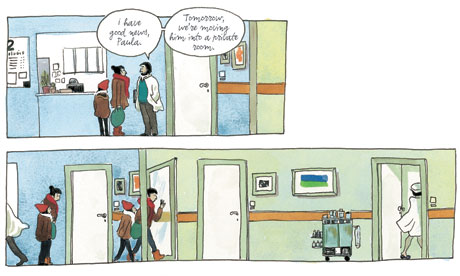
When I read the words "a moving story about cancer, and its effect on one ordinary family", my instinct, whether staring at a movie poster or the jacket of a paperback, is to run a mile. I dread mawkishness the way some people fear blue cheese or spiders. So I was trepidatious when I opened Belgian comic artist Julie Vanistendael's new book, When David Lost His Voice, which is – you guessed it – a moving story about cancer, and its effect on one ordinary family. If I caught sight of anything even remotely resembling a group hug, this one would go straight to the Salvation Army shop. I needn't have worried. This is an amazing book, one of the best published by the clever people at Self Made Hero so far.
Its author, to my huge relief, doesn't pretend that cancer isn't frightening, and she knows – I'm guessing she has first-hand experience of this – that for the friends and relatives of sufferers, it is an illness that induces anger as often as grief. In this sense, then, she has written a surprisingly tough book. Her artist's hands are, you might say, balled tightly into fists. But there is a softness here, too. It comes courtesy of her illustrations, which are delicate, intimate and extremely beautiful, and with the occasional moment of whimsy: a child who finds a mermaid at the bottom of a lake; a parent who pretends that letters are delivered by balloons rather than postmen.
David, a bookseller, has a tumour on his larynx, and does not have long to live. This news comes as a terrible shock but, as he is enfolded into the arms of exhaustion and morphine, inevitably he loses the greater part of his fear. His family, on the other hand, are plainly terrified. His grownup daughter, Miriam, has recently given birth to a child of her own, and though this affords her a certain swoony detachment, it makes her vulnerable, too, the circle of life so suddenly and starkly before her. His nine-year-old daughter, Tamar, is determined to find a way around his death, and thinks that mummification – she could keep his soul in a jam jar – might be the answer. His artist wife, Paula, seeks refuge in work, crafting a skeleton from his x-rays and ruthlessly abandoning his sick bed while she goes to teach abroad.
It's powerful, watching these three girls try to duck grief; you know their denial will slap them across the face in the end. But I was struck more by the way Vanistendael depicts their alarm at the physical changes in David. He doesn't just look or feel different; he smells different. She does it so cleverly, capturing a simple, moving truth: we start to miss a person long before they die, and it's this first loss that enables us to survive the second.

